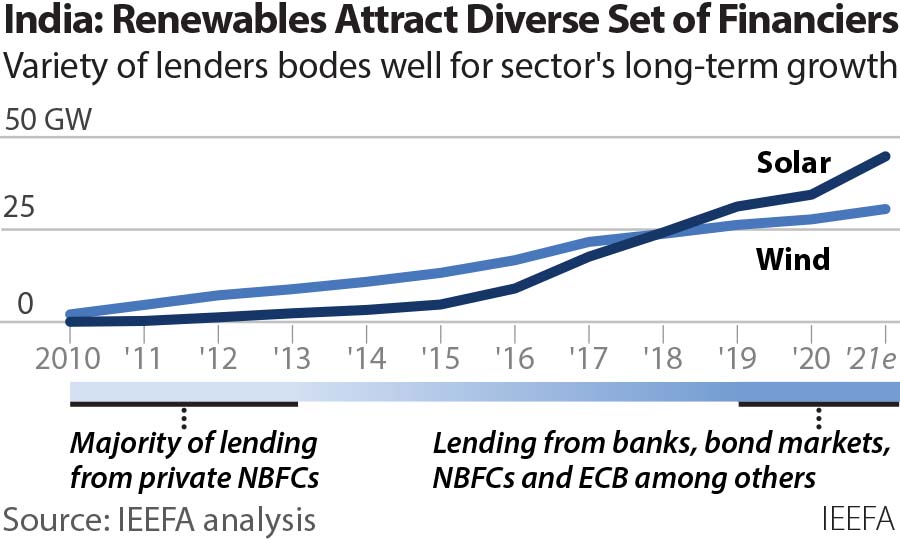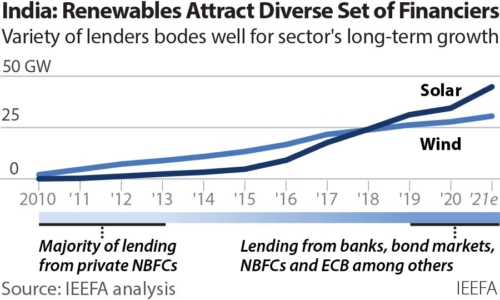IEEFA India: With green bonds announced in Budget 2022, the sun continues to shine for renewable energy financing

3 February 2022 (IEEFA India): As India’s renewable energy sector growth continues to outpace all other global economies, as shown in a new report out today by the Institute for Energy Economics and Financial Analysis (IEEFA), the Budget announcement on issuing green bonds – which are among the most widely used instruments for funding green infrastructure – will massively support this trajectory.
The union budget 2022 unveiled by India’s finance minister yesterday includes a plan for issuing sovereign green bonds for projects that will assist in reducing the carbon intensity of the economy.
Sovereign green bonds have been issued by several countries in the recent past such as France, Germany, the UK and Indonesia, among several other nations, and will prove to be an essential source of capital for emerging countries to fund their energy transition journey.
Report co-author, IEEFA’s Shantanu Srivastava says the sovereign issuance will assist green energy companies in India gain access to cost effective financing.
“While no other details have been shared regarding the issuance size and allocation for specific industries and technologies, this is a welcome move,” says Srivastava. “And it in fact echoes what has already been happening. Several industry players have raised capital through the green bond route in the past.”
In 2022, it is clear the sun – literally – will shine on this massive growth area
IEEFA’s new report finds India’s renewable energy financing market has transformed massively over the past decade to include a plethora of different players vying for a piece of the growing sector.
“All such opportunities will lead to more innovation, more aggression and more opportunities for all stakeholders,” says report co-author, infrastructure finance specialist Ankur Saboo.
“In 2010, renewables were considered a sunrise sector. In 2022, it is clear the sun – literally – will shine on this massive growth area for a long time ahead, building India’s energy security while driving both system deflation and decarbonisation.”
In January 2010, the National Solar Mission (NSM) was launched with an initial target of 20 gigawatts (GW) of installed solar power by 2022 but the target, revised twice, now stands at 100GW of solar PV to be installed by the end of this year.
The growth has been supported by an equally large amount of domestic and global capital, as both debt and equity, invested in Indian renewable energy infrastructure. Debt, the main fodder for renewable energy projects, has come through various channels as the industry matured and as financiers from all quarters gained a better understanding of its risk return dynamics.
Private non-banking financial companies (NBFCs) were the first entities to test the waters by lending to renewable projects, when capital from other conventional sources such as banks, private or public, found it best to avoid exposure to a nascent and evolving technology.
Financing has transformed significantly since then as sources expanded. Banks (private and public), the bond market (domestic and global), international lenders, development finance institutions (DFIs) and other sources of debt now compete for a piece of the growing renewable energy sector.

Private NBFCs, the flag bearers at the start of the journey, have been overshadowed by larger banks, primarily the State Bank of India (SBI), then HDFC Bank, Axis Bank and, more recently, ICICI Bank – completely changing the renewable energy finance landscape.
Mutual funds entered the market through the domestic bond route soon after the banknote demonetisation undertaken by the Government of India in 2016, helping renewable energy companies by providing lower rates, increasing lender competition, adding a new avenue for funding operating projects and helping companies reduce exposures with certain lenders where exposure norms were hit.
“The biggest boon for the renewable energy sector has been access to global bond markets,” says Srivastava. “The international bond market has demonstrated immense depth, proactiveness and boldness towards the sector, thanks to global understanding, high yield offerings and the initial success and pedigree of large players.
The biggest boon for renewable energy has been access to global bond markets
“With sovereign green bonds in the mix now, several global investors will be interested in taking exposure to the Indian market, given the instruments’ sovereign ratings.”
Saboo says: “With increasing complexity and project sizes, the meaningful presence of these different players bodes well for continued growth of the sector. For a capital-intensive area, a highly competitive funding landscape is arguably the biggest growth driver.”
On the equity side, by virtue of the social, environmental and economic impact, renewables have long attracted funds from numerous long-term investors. Such investments have come from international sovereign entities including ENEL and Engie, as well as the largest pension funds, among them CDPQ and Canada Pension Plan Investment Board (CPPIB).
For India, a near zero to 100GW renewable capacity is an exceptional journey so far. The challenge will be to maintain focus on the path from 100GW to 500GW. Critical factors for sustained financing include lenders adapting to the evolving renewable market, tapping environment focused investors, building a dedicated infrastructure finance bank in India and careful evaluation and financial structuring of the technological shift towards Indian modules and inverters.
More immediately, there are still untapped opportunities in green field projects, hybrid, storage and round the clock bids, and household plus commercial and industrial (C&I) rooftop projects.
Full report: Renewable energy finance landscape in India
Authors Contact: Shantanu Srivastava ([email protected]), Ankur Saboo ([email protected])
Media Contact: Kate Finlayson ([email protected]) +61 418 254 237
About IEEFA: The Institute for Energy Economics and Financial Analysis (IEEFA) examines issues related to energy markets, trends and policies. IEEFA’s mission is to accelerate the transition to a diverse, sustainable and profitable energy economy.












